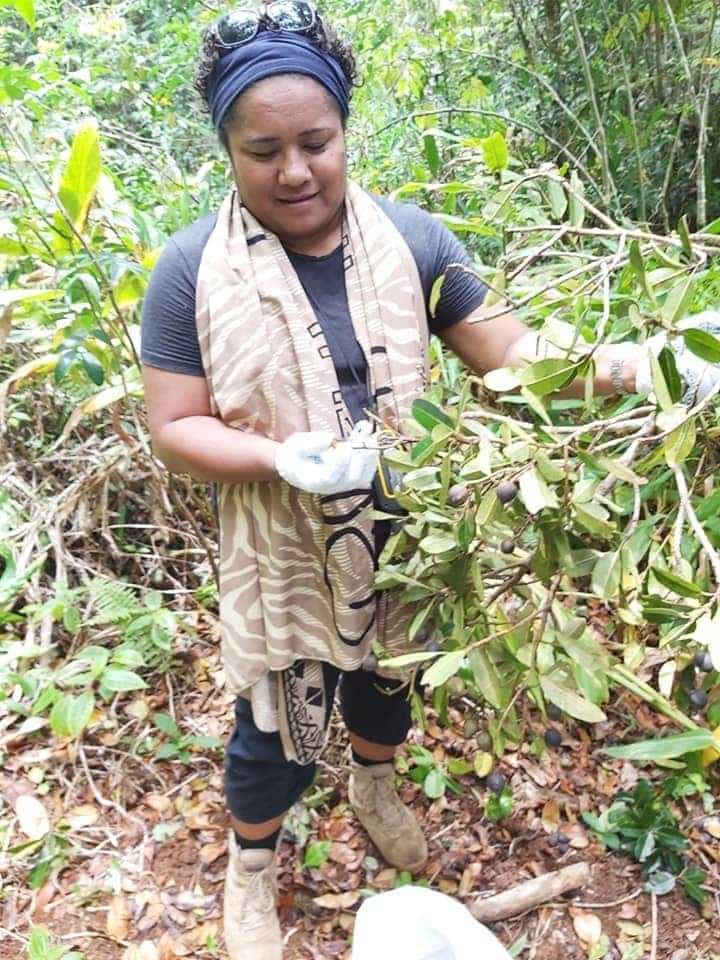Growing up, Elina Nabubuniyaka-Young, remembered being surrounded by forest and natural water bodies weaving itself around the Colo-i-Suva Forest National Park near the compounds of the Department of Forestry.
Blanketed by the early morning mist, the forest loomed large in the background and in some ways – her life.
“My father was a mechanic for the Ministry of Forestry, so we stayed at the staff quarters of the Department of Forestry for many years,” she said with a smile.
The distinct smell of wet soil and the damp forest is what Elina vividly remembers while exploring the native trees that grew within.
Elina would observe the tree climbers and tree spotters whose jobs were to identify trees that were bearing fruit and to collect its seeds.
“We would fill the potting bags in the nursery for the staff to plant the seeds in. The seeds were sown and kept in the nurseries to establish research plots or provided to communities when they requested seedlings for planting,” she reminisced.
Now a Tree Seed specialist at the Pacific Community’s Centre for Pacific Crops and Trees (CePaCT), her work focuses primarily around seed technology, conservation techniques, and seed bank management.
She ensures she correctly identifies the matured seeds, the DBH (diameter at breast height) of the sampled tree is taken, and GPS co-ordinates recorded before the seed collection begins.
She then tests the seeds for its viability before its kept at the regional seed bank, CePaCT for distribution to member countries.
At a time when pandemics, pests and diseases, and extreme weather events are rampant, such work has never been more crucial.
Scattered far and wide over the largest expanse of ocean on earth, Pacific Island countries and territories rely heavily on food imports, tourism, remittances and revenue from labor mobility.
The COVID-19 pandemic changed all that after it crippled the global and local supply chains, which has affected the region’s food system.
Most rural populations, while able to produce and consume their food, rely on imported fertilisers and livestock feed.
Without this resource, domestic production is at risk.
Added to the island countries’ vulnerability are constant threats of natural disasters and climate change.
Elina’s work at CePaCT contributes to food security by providing crops that can mature faster and giving better nutritional varieties to member countries.
The CePaCT vault contains more than 2000 accessions of 17 crops and over 1000 taro accessions – the largest collection in the world.
Its role includes identifying, conserving, and sharing crops resistant to disease and adaptable change.
Since 2012, Elina has collected over 300 kg of seeds from Fiji Samoa, Tonga, Vanuatu, and the Solomon Islands.
“For us in the Pacific region – the land is a very sensitive issue. We do a traditional protocol before we carry out seed collections,” she explains.
“We explain to the landowners, the purpose of the trip, and sometimes we think the people in the villages are not interested, but they are curious about the work that we do. In the evenings while enjoying a bowl of grog, they would ask questions like when is the right time to collect seeds? How do we plant or identify the right trees for seed collection?”
“When I went to the Solomon Islands, I learned some very interesting facts about the dilo (Calophyllum inophyllum) leaves. They crush the leaves in water and then dab it on the eyes to cure conjunctivitis.”
The process of carrying out seed collection is comprehensive.
The Pacific Community (SPC) Land Resources Division works closely with its counterpart – the Ministry of Forestry and the Ministry of Agriculture.
“When I go out for seed collection, I go out with a tree climber and a tree spotter from the Ministry of Agriculture, so it kind of makes my work easier,” said Elina.
“A phenology survey is carried out to see what’s available in the field. For example, when we go to Nadarivatu (a village in the highlands of Viti Levu, the main island of Fiji), we’ll drive through and see if there are any seeds ready for collection, then we do the sevusevu (traditional presentation to ask permission to visit their land).”
“When out in the field, we make sure that the seeds that we do collect are ready or matured, then we collect the diameter breast height of the tree and the associated tree species around it before taking
its GPS coordinates. We ensure the seeds collected are air-dried and kept in breathable bags and not closed plastic bags. This causes the seeds to ‘sweat’ or get moldy and deteriorate.
“When we return to the lab, we start processing the seeds, for example, with Mahogany seeds, we wait for the pod to crack open by itself, or we use a rock or hammer to open it. We remove the wings (impurities)and access the seeds .”
“I carry a viability test on the seed at the CePaCT lab to see whether the seed batch would grow or germinate. From there, I dry it down more before I store it in the cold storage at a temperature range of 3-7 degrees Celsius. These seeds are distributed to member countries upon request.”
“It has been an enriching experience. I have grown a lot in terms of capacity building,” said Elina.
“When I started in this field, it was very male-dominated, but over the years more women are joining in the field. Elina’s message to women and girls is to be bold.
“If you have a passion for something and think it will help our people – go for it.”
The regional seed bank, CePaCT, is supported by Australia, through the Department of Foreign Affairs and Trade and the Australian Centre for International Agricultural Research (ACIAR).




